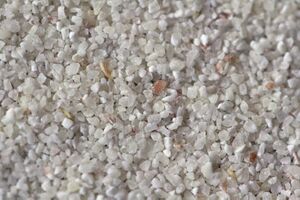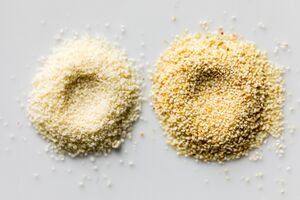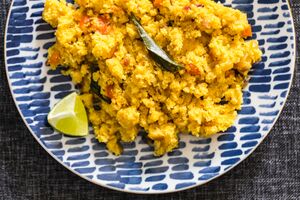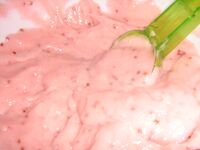سميد
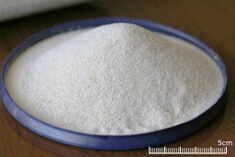 | |
| القيمة الغذائية لكل 100 g (3.5 oz) | |
|---|---|
| الطاقة | 1,506 kJ (360 kcal) |
72.83 g | |
| ألياف غذائية | 3.9 g |
1.05 g | |
| مشبع | 0.15 g |
| أحادي عدم التشبع | 0.124 g |
| متعدد عدم التشبع | 0.43 g |
12.68 g | |
| الڤيتامينات | |
| مكافئ ڤيتامين أ | (0%) 0 μg |
| ثيامين (B1) | (24%) 0.28 mg |
| ريبوفلاڤين (B2) | (7%) 0.08 mg |
| نياسين (B3) | (22%) 3.31 mg |
| ڤيتامين B6 | (8%) 0.1 mg |
| فولات (B9) | (18%) 72 μg |
| ڤيتامين ب12 | (0%) 0 μg |
| Vitamin C | (0%) 0 mg |
| آثار فلزات | |
| كالسيوم | (2%) 17 mg |
| حديد | (9%) 1.23 mg |
| الماغنسيوم | (13%) 47 mg |
| فوسفور | (19%) 136 mg |
| پوتاسيوم | (4%) 186 mg |
| صوديوم | (0%) 1 mg |
| زنك | (11%) 1.05 mg |
| مكونات أخرى | |
| ماء | 12.67 g |
| |
| Percentages are roughly approximated using US recommendations for adults. Source: USDA Nutrient Database | |
Semolina is the name given to coarsely milled durum wheat mainly used in making pasta[1] and sweet puddings. The term semolina is also used to designate coarse millings of other varieties of wheat, and sometimes other grains (such as rice or maize) as well.
Etymology
Semolina is derived from the Italian word semolino,[2] 1790–1800; alteration of Italian semolino, equivalent to semol(a) "bran" (لاتينية: simila, lit. 'flour') + -ino diminutive suffix. Of Semitic origin; Hebrew root smd "to grind into groats" (cf. samīd).[3]
Production
Modern milling of wheat into flour is a process that employs grooved steel rollers. The rollers are adjusted so that the space between them is slightly narrower than the width of the wheat kernels. As the wheat is fed into the mill, the rollers flake off the bran and germ while the starch (or endosperm) is cracked into coarse pieces in the process. Through sifting, these endosperm particles, the semolina, are separated from the bran. The semolina is then ground into flour. This greatly simplifies the process of separating the endosperm from the bran and germ, as well as making it possible to separate the endosperm into different grades because the inner part of the endosperm tends to break down into smaller pieces than the outer part. Different grades of flour can thus be produced.[4]
Types
Semolina made from hard durum wheat (Triticum turgidum subsp. durum) is pale yellow in color.[5] It may be milled either coarse or fine, and both are used in a wide variety of sweet and savory dishes, including many types of pasta. Common names in other languages include:
- Italian: semola di grano duro; coarse (no descriptor), fine rimacinata
- Greek: simigdáli σιμιγδάλι; coarse chondró χονδρό, fine psiló ψιλό
- Arabic: samīd سميد; coarse ḵašin خشن, fine nāʿim ناعم
- Turkish: irmik; coarse iri, fine ince
- Pakistani (Urdu): sooji سوجی
- Hindustani: baṃsī ravā, bansi rava बंसी रवा (milled only coarse, not fine)
Semolina made from common wheat (Triticum aestivum) is beige in color. In the United States, it is called farina (not to be confused with Italian farina, which is common-wheat flour), and it is used more often for desserts than for savory foods. On the Indian subcontinent, common-wheat semolina may be milled either coarse or fine, and both are used in a wide variety of both sweet and savory dishes. Common names in other languages include:
- Assamese: sūjī চুজি
- Bangla: śūjī সুজি
- Gujarati: sōjī સોજી
- Hindustani: sūjī सूजी/سوجی, or ravā रवा; coarse moṭī मोटी, fine bārīk बारीक
- Kannada: rave ರವೆ
- Malayalam: ṟava റവ
- Dhivehi: ravā ރަވާ
- Marathi: ravā रवा
- Nepali: sūjī सूजी
- Punjabi: sūjī ਸੂਜੀ
- Sinhala: rulang රුලං
- Tamil: ravai ரவை
- Telugu: ravva రవ్వ
Broadly speaking, meal produced from grains other than wheat may also be referred to as semolina, e.g., rice semolina and corn semolina. Corn semolina is commonly called grits in the United States.
Dishes
Savory
In Germany, Austria, Hungary, Bosnia-Herzegovina, Bulgaria, Serbia, Slovenia, Romania, Slovakia and Croatia, (durum) semolina is known as (Hartweizen-)Grieß (a word related to "grits") and is mixed with egg to make Grießknödel, which can be added to soup. The particles are fairly coarse, between 0.25 and 0.75 millimeters in diameter. It is also cooked in milk and sprinkled with chocolate to be eaten as breakfast.
In Italy, (durum) semolina is used to make a type of soup by directly boiling fine semolina in vegetable or chicken broth. Semolina can also be used for making a type of gnocchi called gnocchi alla romana, where semolina is mixed with milk, cheese and butter to form a log, then cut in discs and baked with cheese and bechamel.
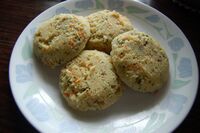
Semolina is a common food in West Africa, especially among Nigerians. It is eaten as either lunch or dinner with stew or soup. It is prepared just like eba (cassava flour) or fufu with water and boiled for 5 to 10 minutes.
In much of North Africa, durum semolina is made into the staple couscous and different kinds of flat breads like m'semen, kesra, khobz and other.
In Pakistan and North India semolina is called sooji, and in South India, rava. Semolina is used to make savory South Indian foods, such as rava dosa, rava idli, rava kitchri and upma. It is used to coat slices of fish before it is pan-fried in oil. Rotis can also be made from semolina.
Sweet
In the UK, the flour is mixed with hot milk, sugar and vanilla to make a warm pudding dessert. It has fallen out of favour in recent times due to the slight coarseness that the grains retain. Prior to 1980, it was a staple pudding served in school lunches.
In Austria, Germany, Hungary, Bulgaria, Bosnia-Herzegovina, Slovenia, Serbia, Romania, Croatia, Slovakia, and the Czech Republic, common wheat semolina is called Weichweizengrieß in German, but is often referred to as Grieß). It is often cooked with milk and sugar or cooked with just milk and then topped with sugar, cinnamon, Ovaltine or other sweet toppings. A dollop of butter is also often added. This dish is called Grießkoch in Austria, Grießbrei in Germany, and semolina pudding in English. Grießauflauf consists of semolina mixed with whipped egg whites, and sometimes fruit or nuts, and then baked in the oven.
A baked dish containing semolina called migliaccio is found in the Neapolitan tradition in Italy. Migliaccio is a mixture of ricotta, vanilla and citrus peel, similar to the filling in sfogliatelle, with added semolina flour to obtain a simple, firm cake.
In Slovakia, Sweden, Estonia, Finland, Lithuania, Latvia, Poland, Romania, Ukraine, Belarus, Israel, and Russia, it is eaten as a breakfast porridge, sometimes mixed with raisins and served with milk. In Swedish, it is known as mannagrynsgröt, or boiled together with blueberries, as blåbärsgröt. In Sweden, Estonia, Finland, and Latvia, semolina is boiled together with juice from berries and then whipped into a light, airy consistency to create klappgröt (Swedish name), also known as vispipuuro (Finnish name) or mannavaht (Estonian name) or debessmanna (Latvian name). This dessert often eaten in the summer.
In the Middle East and North Africa, basbousa (also called harisa in some varieties of Arabic) is a sweet semolina cake soaked in fragrant syrup and frequently topped with nuts. In North Africa, it is also used to make harcha, a kind of griddle cake often eaten for breakfast, commonly with jam or honey.[6] Baghrir, a North African pancake, is also made with semolina or flour that is served for breakfast.
In Indian subcontinent, semolina (called Rava, suji or shuji) is used for such sweets as halwa and rava kesari. Semolina vermicelli is also used to make a pudding called seviyan. In Nepal, semolina is called suji and is used for preparing sweet dishes such as haluwa or puwa. In Myanmar (Burma), semolina (called shwegyi) is used in a popular dessert called sanwin makin. In Sri Lanka semolina is called rulan and used to make creamy porridge and a sweet confectionery called "rulan aluwa".
Halwa is sometimes made with semolina cooked with sugar, butter, milk, or pine nuts. It is a popular treat in Turkey (helva), Greece, (halvas), Cyprus (halvas), Bulgaria (halva), Iran (halva), Pakistan (halva), Bangladesh (halua), Palestine (khalva), and Israel (halvah). In Turkey, sweet dishes called revani, şekerpare and şambali are made with semolina. In Greece, the dessert galaktoboureko is made by making a custard from the semolina and then wrapping it in phyllo sheets. In Cyprus, the semolina may be mixed also with almond cordial to create a light, water-based pudding.
In baking
As an alternative to corn meal, semolina can be used to flour the baking surface to prevent sticking. In bread making, a small proportion of durum semolina added to the usual mix of flour is said to produce a tasty crust.[بحاجة لمصدر]
See also
References
- ^ "Semolina – Definition". Merriam-Webster. Retrieved 2017-04-01.
- ^ "Semolina". Oxford English Dictionary. Retrieved August 25, 2019.
- ^ "semolina". The American Heritage Dictionary. Houghton Mifflin Harcourt Publishing Company. Retrieved August 25, 2019.
- ^ Wayne Gisslen (2001), Professional Baking, John Wiley & Sons
- ^ "Semolina Flour". Spiritfoods. Archived from the original on 6 September 2012. Retrieved 21 September 2012.
- ^ Anthony Ham; Paula Hardy; Alison Bing (2007). Morocco. Lonely Planet. p. 74. ISBN 978-1-74059-974-0.
External links
 Media related to Semolina and wheat farina at Wikimedia Commons
Media related to Semolina and wheat farina at Wikimedia Commons- قالب:Merriam-Webster
- Short description is different from Wikidata
- Articles with hatnote templates targeting a nonexistent page
- Articles containing إيطالية-language text
- Articles containing لاتينية-language text
- Articles containing ألمانية-language text
- Articles containing سويدية-language text
- Articles containing فنلندية-language text
- Articles containing إستونية-language text
- Articles containing لاتڤية-language text
- Articles with unsourced statements from April 2013
- Breakfast cereals
- Cereals
- Wheat
- Algerian cuisine
- Arab cuisine
- Egyptian cuisine
- Greek cuisine
- Iraqi cuisine
- Israeli cuisine
- Jordanian cuisine
- Lebanese cuisine
- Libyan cuisine
- Moroccan cuisine
- Pakistani cuisine
- Palestinian cuisine
- Syrian cuisine
- Tunisian cuisine
- Ukrainian cuisine
